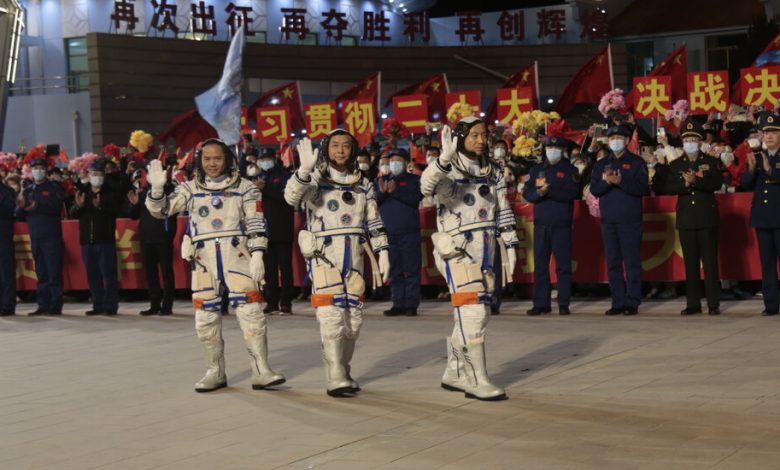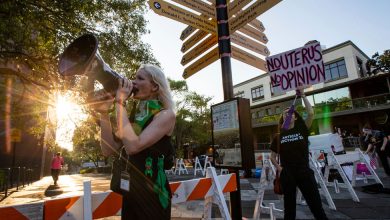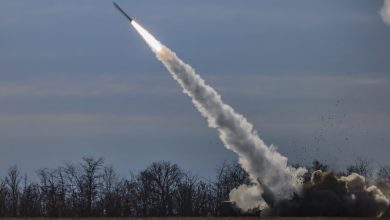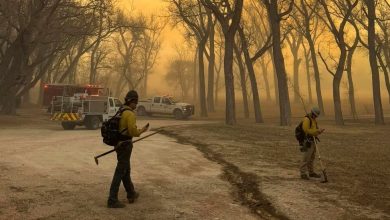Your Tuesday Briefing: China’s Space Push


Chinese astronauts left Earth last month.Credit…Li You/The New York Times
China’s marathon race in space
Instead of running a head-to-head space race against the U.S., China has set off on a marathon. It’s making good time.
In late October, China completed the assembly of its Tiangong space station. Late last month, three Chinese astronauts took off from the Jiuquan Satellite Launch Center and landed at the space station, beginning the permanent occupancy of the outpost.
These achievements, combined with recent probes to the moon and Mars, show China’s growing success. My colleague Keith Bradsher made a rare foreign visit to a desert rocket base in Jiuquan, where senior space officials described plans for a new space station and reusable rockets.
They also discussed ambitions to travel beyond near-Earth orbit and put astronauts on the moon. And they outlined an even bigger prize: sending humans to Mars.
Analysis: Seeking to burnish its prestige in the world, China is portraying Tiangong as a space station for scientists everywhere, especially in countries without established space programs.
History: Here’s a timeline of China’s advancements in spaceflight.
Reaction: In August, the U.S. predicted that China would surpass its space capabilities by 2045.
China’s Covid plan: More shots
China has launched an all-out campaign to convince older citizens that its latest Covid-19 vaccines are easy to take and effective.
The vaccine is inhaled instead of injected, which could reduce the fear of a needle prick. In state-run media, one woman quipped that getting her booster was “a bit like drinking milk tea.” A man in Wenzhou reassured the hesitant that “it doesn’t hurt at all, and it’s a little sweet.”
Understand What Is Happening in China
- A Victory for Protesters: Beijing’s costly policy of lockdowns pummeled China’s economy and set off mass public protests that were a rare challenge to its leader, Xi Jinping.
- A Messy Pivot: The Communist Party cast aside many Covid rules after the protests, while playing down the threat of the virus. The move could prove dangerous.
- A ‘Tipping Point’: For the protesters, public dissent was unimaginable until recently. We asked young Chinese about what led them to take the risk.
- Tracking Protesters: The authorities in China used the country’s all-seeing surveillance apparatus to track, intimidate and detain those who marched in the protests.
The campaign is critical. As China drops its restrictions after protests, it’s bracing for a surge in cases that could overwhelm its medical resources. The deadliness of coming outbreaks depends in part on whether older adults are willing to be inoculated.
But officials also have to overcome a deeply ingrained skepticism, which they helped instill. In early 2021, when China introduced its domestic vaccine, regulators restricted use to people between the ages of 18 to 59. That made many people think it was unsafe for older adults.
China’s vaccines are also usually less effective than foreign mRNA vaccines, and little is known about the real-world efficacy of the inhaled treatment.
Other challenges: Health experts, looking at the precedents set by Hong Kong and Singapore, have also warned that the campaign might be too late to defend against the current wave of cases. Within China’s oldest segment of the population, 40 percent have not received a booster.
Details: China also plans to deactivate its Covid-19 app today, CNN reports. The app has governed daily life for years, dictating people’s movements. The government may have used the app to quash dissent.
Japan’s push for India’s tech talent
Japan faces a dearth of IT engineers, and India produces 1.5 million engineering graduates each year. But Japan is having a hard time recruiting highly educated Indians when opportunities in the U.S. and Europe beckon.
Japan desperately needs more workers as its population ages. In the tech sector alone, the government estimates that the shortfall in workers will reach nearly 800,000 in the coming years as Japan pursues a long-overdue national digitization effort.
But even though the country has tried to attract foreign workers and recruit tech talent in India, it faces steep challenges. Lower pay, rigid corporate hierarchies and steep language barriers make Japan a less attractive option. In the U.S., for instance, average tech salaries are more than twice as much as those in Japan.
Culture: Japan’s ambivalence toward foreigners means the country does not have an established way to integrate them into society.
Tech: Japan, the world’s third-largest economy, has struggled to transition from physical paperwork to digital tools. Japanese companies’ use of cloud technologies is nearly a decade behind those in the U.S.
THE LATEST NEWS
Asia Pacific
-
Australia is trying to move a rare tortoise to a cooler environment. The experiment is believed to be the first attempt to relocate an endangered vertebrate species because of climate change.
-
Six people were killed after an ambush and standoff in Queensland, Australia, The Guardian reports. Two were police officers.
-
Indonesia recently criminalized sex outside of marriage. Bali’s governor said tourists would not be affected, The Guardian reports.
-
South Korea has found a home for two dogs, which North Korea’s leader gave to its former president. After a disagreement about the cost of their care, the dogs will live in a zoo, The Associated Press reports.
Around the World
-
Iran publicly hanged a man. It is believed to be the second execution of a protester since the Islamic Republic began cracking down on antigovernment protests.
-
A gunman in Rome killed three women, including a friend of Italy’s new prime minister.
Other Big Stories
-
Karen Bass is now Los Angeles’s first female mayor. Yesterday, she declared a state of emergency on homelessness.
-
Scientists have made a potential breakthrough in fusion research.
-
A prince stored explosives in his hunting lodge as part of a plot to overthrow the German government.
The War in Ukraine
-
Vladimir Putin, Russia’s president, won’t hold his traditional December news conference. The annual event was one of the few times that foreign reporters could question him directly.
-
G7 nations agreed to set up a donor platform to funnel money to Ukraine.
-
Russia is using old Ukrainian missiles against Ukraine, a Ukrainian general said.
Opinions
-
Twitter can’t be the world’s “town square.” That’s a good thing, Ezra Klein argues.
-
Amanda Foreman believes that former Princess Mako of Japan and her husband, Kei Komuro, are finally free and independent in the U.S.
-
The Islamic Republic will fall in Iran, Karim Sadjadpour writes. The only question is when.
A Morning Read
Times Styles writers and editors have selected their 93 most stylish “people” of 2022.
Not everything on the list is a person. There are nonhumans, like the spotted lanternfly and the James Webb Space Telescope. There are movie characters, like Lydia Tár. And, of course, Beyoncé makes the cut.
ARTS AND IDEAS
Drilling, and heritage
The Burrup Peninsula on Australia’s northwest coast could be a key spot for Australia’s mining push. A major liquefied natural gas project is set to supercharge drilling off the coast, and plants will be built to process it.
But the peninsula, called Murujuga by Aboriginal people, is also home to a million petroglyphs believed to be up to 50,000 years old. They document extinct animals and include some of the oldest depictions of the human face.
Indigenous Australians fear that the new construction will threaten sacred heritage sites. The project will be one of Australia’s most polluting developments, progressive research institutes and experts say — it could release almost 1.8 billion tons of emissions. Indigenous leaders say they have few options; they can only negotiate terms, not veto projects.
“We don’t have the voice to say no,” one Indigenous man told The Times. “We legally don’t.”
PLAY, WATCH, EAT
What to Cook
These shortbread cookies sparkle.
What to Read
“Ghost Town” recounts the messy and contested memories of a Taiwanese family.
What to Watch
Mia Hansen-Love directs Léa Seydoux in “One Fine Morning,” a delicate look at daily life.
Relationships
More married couples are “living apart together.”
Now Time to Play
Play the Mini Crossword, and a clue: Shine brightly (five letters).
Here are the Wordle and the Spelling Bee.
You can find all our puzzles here.
That’s it for today’s briefing. See you next time. — Amelia
P.S. We want to hear about the ways your household uses digital assistants. Find Alexa creepy? Tell us about that, too.
“The Daily” is on the U.S. job market and layoffs.
You can reach Amelia and the team at [email protected].





